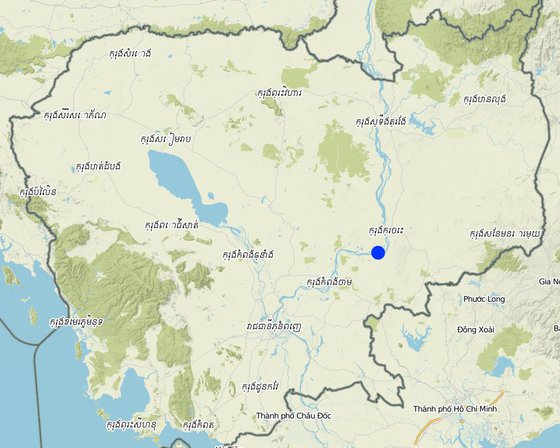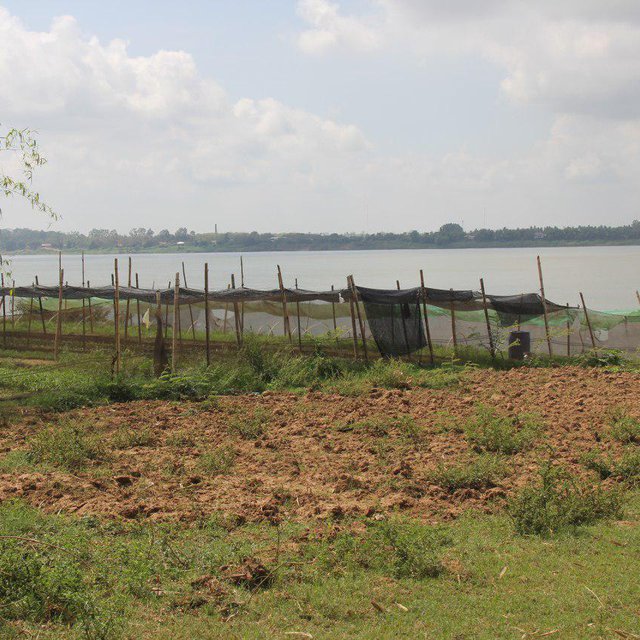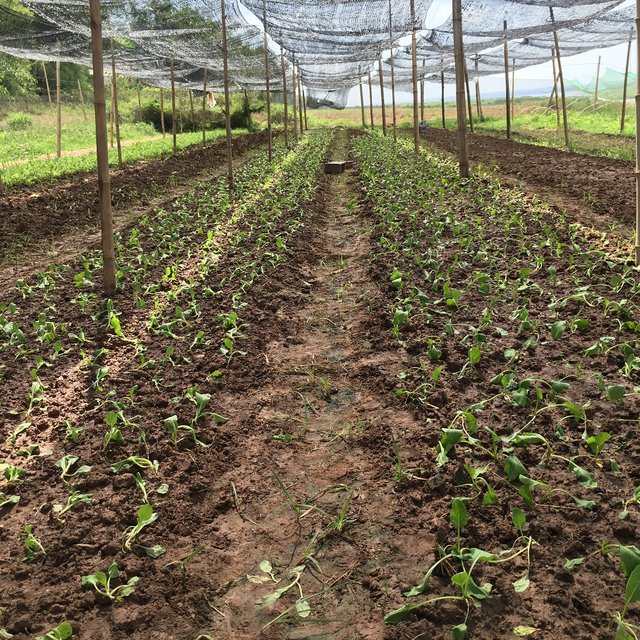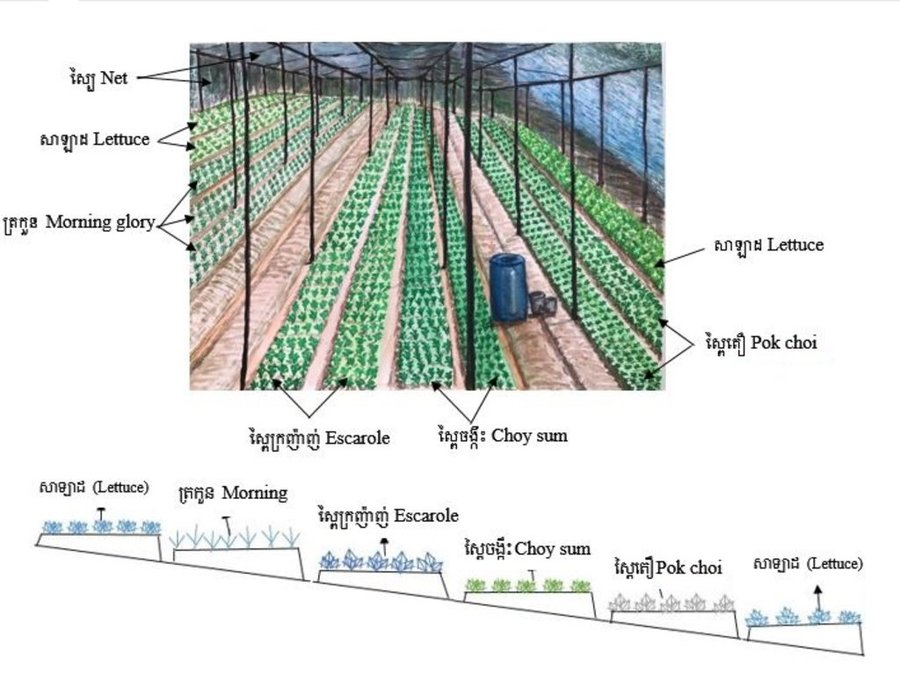



ការដាំដំណាំឆ្លាស់ជាវិធីសាស្ត្រនៃប្រព័ន្ធដាំដុះដែលមានការដាំដំណាំប្រភេទផ្សេងៗក្នុងរងដោយឡែកៗ ហើយឆ្លាស់រៀងគ្នាក្នុងពេលតែមួយ (Pawan et al., 2012)។ ដំណាំដែលកសិករបានជ្រើសរើសយកមកដាំរួមមាន សាឡាដ ស្ពៃតឿ ស្ពៃចង្កឹះ ស្ពៃក្រញ៉ាញ់ និងត្រកួន។ បច្ចេកទេសនេះបានអនុវត្តនៅលើផ្ទៃដីទំហំ ១០៨០ ម៉ែត្រការ៉េនៅតាមច្រាំងទន្លេមេគង្គ ក្នុងខេត្តក្រចេះ។ ក្នុងការអនុវត្តបច្ចេកទេសនេះកសិករបានរៀបចំដី រួចហើយលើកជារងកាត់ទទឹងជម្រាលច្រាំងទន្លេ។ នៅរងដំបូងដាំសាឡាដរងបន្តបន្ទាប់ដាំស្ពៃតឿ ស្ពៃចង្កឹះ ស្ពៃក្រញ៉ាញ់ ត្រកួន រួចសារឡើងវិញដោយចាប់ផ្តើមពីសាឡាដដដែល។ ការដាំដំណាំចម្រុះ ហើយឆ្លាស់គ្នាបានជួយកាត់បន្ថយការបំផ្លាញពីសត្វល្អិតដោយដំណាំសាឡាដជាប្រភេទបន្លែដែលសត្វល្អិតមិនចូលចិត្តស៊ីដោយសារវាមានរសជាតិល្វីង។ នៅពេលដែលដាំដំណាំឆ្លាស់សត្វល្អិតដែលមិនត្រូវការប្រភេទដំណាំនេះវានឹងបកត្រឡប់ថយក្រោយវិញដែលជាហេតុជួយកាត់បន្ថយការបំផ្លាញពីសត្វល្អិតដល់ដំណាំនៅរងបន្ទាប់ដែលជាប្រភេទដែលសត្វល្អិតចូលចិត្ត និយាយរួម គឺការបំភ័ន្តសត្វល្អិតដោយ បន្លែដែលសត្វល្អិតមិនចូលចិត្ត។
ដំណាំងាយនឹងទទួលរងការបំផ្លាញទាំងស្រុងពីសត្វល្អិតនៅពេលដែលដាំដំណាំតែមួយប្រភេទកបនឹងសត្វល្អិតប្រភេទណាមួយនោះ តែបើដាំឆ្លាស់ទោះបីជារងការបំផ្លាញលើដំណាំប្រភេទណាមួយក៏នៅសល់ប្រភេទដំណាំផ្សេងទៀតដែលមិនរងការខូចខាតដែរ។ ដើម្បីអនុវត្តន៍បច្ចេកទេសនេះឱ្យកាន់តែមានប្រសិទ្ធភាពកសិករបានប្រើប្រាស់ថ្នាំពុលធម្មជាតិដែលអាចផលិតបានដោយខ្លួនឯងផ្ទាល់ដោយ ប្រើគ្រឿងផ្សំពីរុក្ខជាតិដូចជា សម្បកស្តៅ វល្លិបណ្តូលពេជ្រ សម្បកស្លែង មើមក្បៀស។ល។ យកមកបុកហើយត្រាំទឹកទុកក្នុងរយៈពេល ១៥ ថ្ងៃទើបអាចយកមកប្រើប្រាស់បាន (Yang et al, 2006)។ ទឹកថ្នាំ ១ លីត្រ លាយជាមួយទឹកធម្មតា ១៥ លីត្របាញ់ទៅលើដំណាំ ពេលសង្កេតឃើញមានវត្តមានសត្វល្អិតចង្រៃ ហើយធ្វើការត្រួតពិនិត្យជាទៀងទាត់រៀងរាល់ថ្ងៃ។
ចំពោះការរៀបចំដីវិញគឺ ភ្ជួរដីហាលពី ៧ ទៅ ៨ ថ្ងៃទើបលើកជារង និងរោយកំបោរសទុកផ្អាប់រយៈពេល ៦ ថ្ងៃដើម្បីសម្លាប់មេរោគនៅក្នុងដី។ ការសាបកូនស្ពៃក្រញ៉ាញ់ ស្តៃតឿ ស្ពៃចង្កឹះ គឺមានរយៈពេល ២០ ថ្ងៃ ទើបយកមកស្ទូង (ចំណែកត្រកួន គឺដាំដោយគ្រាប់ផ្ទាល់តែម្តង) ដោយឡែកសាឡាដសាបរយៈពេលតែ ១០ថ្ងៃ គឺអាចយកមកស្ទូងបាន។ សាឡាដក្រោយពេលស្ទូងបាន ៣០ ថ្ងៃ គឺអាចប្រមូលផលបាន ចំពោះស្ពៃ និងត្រកួនវិញ គឺប្រមូលផលក្រោយពេលស្ទូង រយៈពេល ៣៨ ថ្ងៃ។ កសិករប្រើជីសរីរាង្គ និងលាមកគោដើម្បីបង្កើនជីជាតិដី។ រីឯការធ្វើរង គឺធ្វើទទឹងជម្រាលដើម្បីការពារការហូរច្រោះដីនៅពេលមានភ្លៀង។ លើសពីនេះដើម្បីការពារកម្តៅថ្ងៃ និងការពារភ្លៀងដែលធ្វើឱ្យប៉ះពាល់ដល់ដំណាំកសិករបានសង់ជារោងបណ្តោះអាសន្នមានកម្ពស់ ២ ម៉ែត្រ ដោយប្រើបង្គោលឫស្សីធ្វើជារោងដោយប្រក់ដំបូលដោយស្បៃ និងហ៊ុមព័ទ្ធជុំវិញដោយស្បៃ ដើម្បីការពារសត្វល្អិត និងសត្វពាហនៈដូចជាឆ្កែ និងមាន់ជាដើម។ ចំពោះតម្លៃកសិផលក្នុង ១ គីឡូក្រាម គឺស្ពៃតឿលក់បានតម្លៃពី ៣០០០ រៀល ទៅ ៤០០០ រៀល ត្រកួនតម្លៃ ២០០០ រៀល ស្ពៃចង្កឹះតម្លៃ ២០០០ រៀល ទៅ ៣០០០ រៀល ស្ពៃក្រញ៉ាញ់តម្លៃពី ៣០០០ រៀល ទៅ ៣៥០០ រៀល និងសាឡាដតម្លៃ ៤០០០ រៀល។

Location: ជាដីដែលនៅមាត់ច្រាំងទន្លេមេគង្គ, ភូមិតាម៉ៅលើ ឃុំកំពង់គរ ស្រុកព្រែកប្រសព្វ ខេត្តក្រចេះ, Cambodia
No. of Technology sites analysed: single site
Spread of the Technology: applied at specific points/ concentrated on a small area
In a permanently protected area?:
Date of implementation: less than 10 years ago (recently)
Type of introduction









| Specify input | Unit | Quantity | Costs per Unit (រៀល) | Total costs per input (រៀល) | % of costs borne by land users |
| Labour | |||||
| រៀបចំដី | នាក់-ថ្ងៃ | 3.0 | 17000.0 | 51000.0 | 100.0 |
| Equipment | |||||
| ម៉ាស៊ីនបូមទឹក | គ្រឿង | 1.0 | 1000000.0 | 1000000.0 | 100.0 |
| ចបកាប់ | ផ្លែ | 1.0 | 13000.0 | 13000.0 | 100.0 |
| រនាស់ | រនាស់ | 1.0 | 15000.0 | 15000.0 | 100.0 |
| ទុយោ | ដុំ | 14.0 | 16000.0 | 224000.0 | 100.0 |
| កញ្ឆេរ | គូ | 1.0 | 50000.0 | 50000.0 | 100.0 |
| Plant material | |||||
| គ្រាប់ពូជសាឡាដ | កញ្ចប់ | 15.0 | 10000.0 | 150000.0 | 100.0 |
| ស្ពៃក្រញ៉ាញ់ | កញ្ចប់ | 15.0 | 6000.0 | 90000.0 | 100.0 |
| ស្ពៃចង្កឹះ | កញ្ចប់ | 6.0 | 6000.0 | 36000.0 | 100.0 |
| ត្រកួន | គីឡូក្រាម | 14.0 | 10000.0 | 140000.0 | 100.0 |
| ស្ពៃតឿ | កំប៉ុង | 2.0 | 7000.0 | 14000.0 | 100.0 |
| Fertilizers and biocides | |||||
| កំបោរ | គីឡូក្រាម | 2.0 | 2500.0 | 5000.0 | 100.0 |
| ជីសរីរាង្គ | បាវ | 1.0 | 130000.0 | 130000.0 | 100.0 |
| Construction material | |||||
| សំណាញ់សម្រាប់ប្រក់ | ដុំ | 3.0 | 260000.0 | 780000.0 | 100.0 |
| ធុងដាក់ស្រោចទឹក | គូ | 1.0 | 50000.0 | 50000.0 | 100.0 |
| ចានដែក | ចានដែក | 3.0 | 10000.0 | 30000.0 | 100.0 |
| ធុងស្តុកទឹក | ធុងទឹក | 1.0 | 80000.0 | 80000.0 | 100.0 |
| ស្បៃនីឡុងសម្រាប់ព័ន្ធជុំវិញ | ដុំ | 3.0 | 58000.0 | 174000.0 | 100.0 |
| Other | |||||
| ជួលដី | ឆ្នាំ | 1.0 | 300000.0 | 300000.0 | 100.0 |
| ឫស្សី | ដើម | 20.0 | 4000.0 | 80000.0 | 100.0 |
| Total costs for establishment of the Technology | 3'412'000.0 | ||||
| Specify input | Unit | Quantity | Costs per Unit (រៀល) | Total costs per input (រៀល) | % of costs borne by land users |
| Labour | |||||
| ការដកស្មៅ (ធ្វើខ្លួនឯង) | នាក់-ថ្ងៃ | 4.0 | 17000.0 | 68000.0 | 100.0 |
| ជ្រោយដី និងដាក់ដី (ធ្វើខ្លួនឯង) | នាក់-ថ្ងៃ | 4.0 | 17000.0 | 68000.0 | 100.0 |
| បាញ់ថ្នាំ | នាក់-ថ្ងៃ | 12.0 | 17000.0 | 204000.0 | 100.0 |
| Equipment | |||||
| ធុងបាញ់ថ្នាំប្រើដោយដៃ | គ្រឿង | 1.0 | 80000.0 | 80000.0 | 100.0 |
| ប្រេងម៉ាស៊ូត | លីត្រ | 90.0 | 2350.0 | 211500.0 | 100.0 |
| Total costs for maintenance of the Technology | 631'500.0 | ||||
កាលពីមុនដាំខ្ទឹមបារាំងតែមួយមុខតែឥឡូវដាំបន្លែចម្រុះឆ្លាស់គ្នា។
កាលពីមុនកសិករប្រើថ្នាំពុលកសិកម្ម និងជីគីមី តែឥឡូវកសិករប្រើថ្នាំពុលធម្មជាតិ និងជីធម្មជាតិ។
កសិករបានដាំដំណាំច្រើនមុខហើយឆ្លាស់រងគ្នាដែលជាហេតុកាត់បន្ថយការបំផ្លាញពីសត្វល្អិត និងប្រើប្រាស់ថ្នាំពុលធម្មជាតិ។
កាលពីមុនកសិករដាំតែដំណាំមួយមុខគឺខ្ទឹមបារាំង ប៉ុន្តែឥឡូវកសិករដាំដំណាំច្រើនមុខដូចជាស្ពៃក្រញាញ់ ស្ពៃចង្កឹះ ស្ពៃតឿ សាឡាដ ត្រកួន។
ដោយសារការដាំដំណាំច្រើនប្រភេទឆ្លាស់គ្នា និងវិលជុំធ្វើឱ្យការស្រូបជីជាតិពីដីក៏ខុសគ្នាដែរ និងប្រើប្រាស់ជីធម្មជាតិធ្វើឱ្យដីសម្បូរជីជាតិ។
កាលពីមុនប្រើថ្នាំពុលកសិកម្មដើម្បីកំចាត់សត្វល្អិត តែក្រោយមកប្រើថ្នាំពុលធម្មជាតិដើម្បីការពារសត្វល្អិត។
កាលពីមុនទិញថ្នាំពុលកសិកម្ម តែឥឡូវមិនទិញថ្នាំពុលកសិកម្មទេព្រោះកសិករចេះធ្វើថ្នាំពុលធម្មជាតិដោយខ្លួនឯង។
ដោយកាត់បន្ថយការទិញ និងប្រើថ្នាំពុលកសិកម្ម និងជីគីមី ដោយត្រឡប់មកប្រើជីធម្មជាតិ និងថ្នាំពុលធម្មជាតិវិញ។
ជីវភាពរបស់កសិករប្រសើរជាងមុនបន្ទាប់ពីអនុវត្តន៍បច្ចេកទេសនេះដោយសារគាត់ទទួលបានប្រាក់ចំណូលច្រើន ដោយសារមានដំណាំច្រើនប្រភេទ និងពុំចាំបាច់ទិញថ្នាំពុលកសិកម្មព្រមទាំងទទួលបានសុខភាពល្អ។
បន្ទុកការងារកើនឡើងតិចតួចដោយសារឥលូវមានដាំដំណាំច្រើនជាងមុន។
ចំពោះសន្តិសុខស្បៀងមានភាពល្អប្រសើរជាងមុនដោយសារកសិករអាចទទួលបានចំណូលប្រសើរឡើងព្រោះពីមុនគាត់ដាំដំណាំតែមួយមុខ តែឥឡូវប្តូរមកដាំដំណាំច្រើនមុខ។
ដោយសារមិនប្រើប្រាស់ថ្នាំពុលកសិកម្មដែលមិនធ្វើឱ្យប៉ះពាល់ដល់សុខភាព។
កសិករចេះផលិតថ្នាំពុលធម្មជាតិដោយខ្លួនឯង និងត្រឡប់មកប្រើប្រាស់ជីធម្មជាតិវិញ។
ទឹកជំនន់ធ្វើឱ្យបាត់បង់ដីល្បាប់ និងកើនកករនៅខ្សែទឹកផ្នែកខាងក្រោមដោយសារការកាប់ជ្រោយដីច្រាំងទន្លេ។
រោងដាំដំណាំប្រក់សំណាញ់ និងធ្វើរងកាត់ទទឹងជម្រាលច្រាំងទន្លេ។
ដំណាំបានជួយរក្សាសំណើមដី និងការធ្វើរោងបណ្តោះអាសន្នកាត់បន្ថយ រំហួត ៦០%។
ដំណាំអាចជួយរក្សាសំណើមដីបានល្អ។
កសិករប្រើប្រាស់លាមកគោដែលទិញពីកសិករផ្សេងទៀត ឬដើររើសនៅតាមវាលស្រែ ចំណែកជីសរីរាង្គទិញពីក្រុមហ៊ុនលក់ជី។
ការដាំដំណាំច្រើនមុខ និងវិលជុំ ដែលដំណាំនីមួយៗស្រូបយកជីជាតិខុសៗគ្នាធ្វើឱ្យដីមានតុល្យភាព។
កាត់បន្ថយបញ្ហាដង្កូវយោលទោង សត្វទៀគូរ និងមេអំបៅ។
នៅពេលកសិករភ្ជួរ និងរាស់ ឬជ្រោយដី ដីនៅស្រទាប់លើនឹងហូរច្រោះនៅពេលដែលមានភ្លៀងធ្លាក់។ ដើម្បីកាត់បន្ថយការហូរច្រោះដីស្រទាប់លើ កសិករបានសង់រោងប្រើដោយដើមឫស្សីប្រក់ស្បៃ និងធ្វើរងកាត់ទទឹងជម្រាល ដូចនេះកករដីដែលហូរទៅខ្សែទឹកខាងក្រោយកើនឡើងតិចតួច។